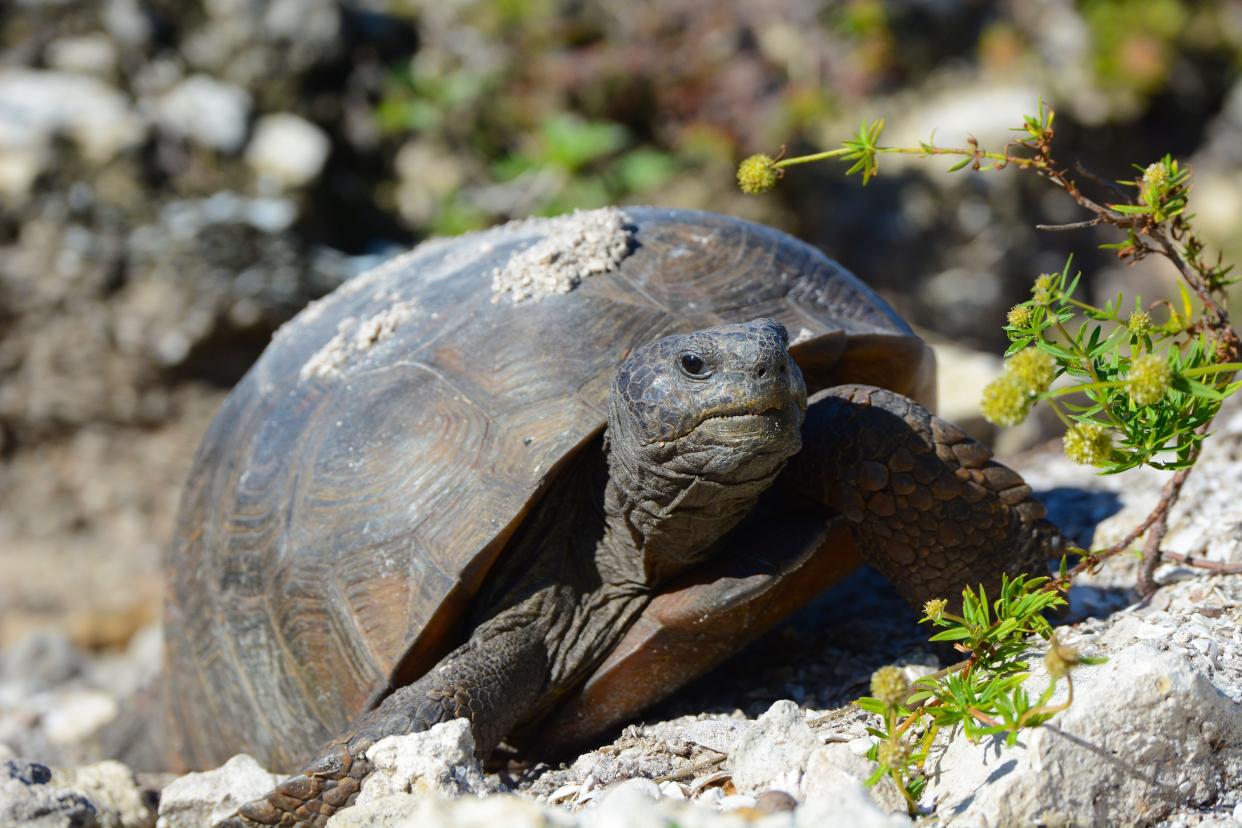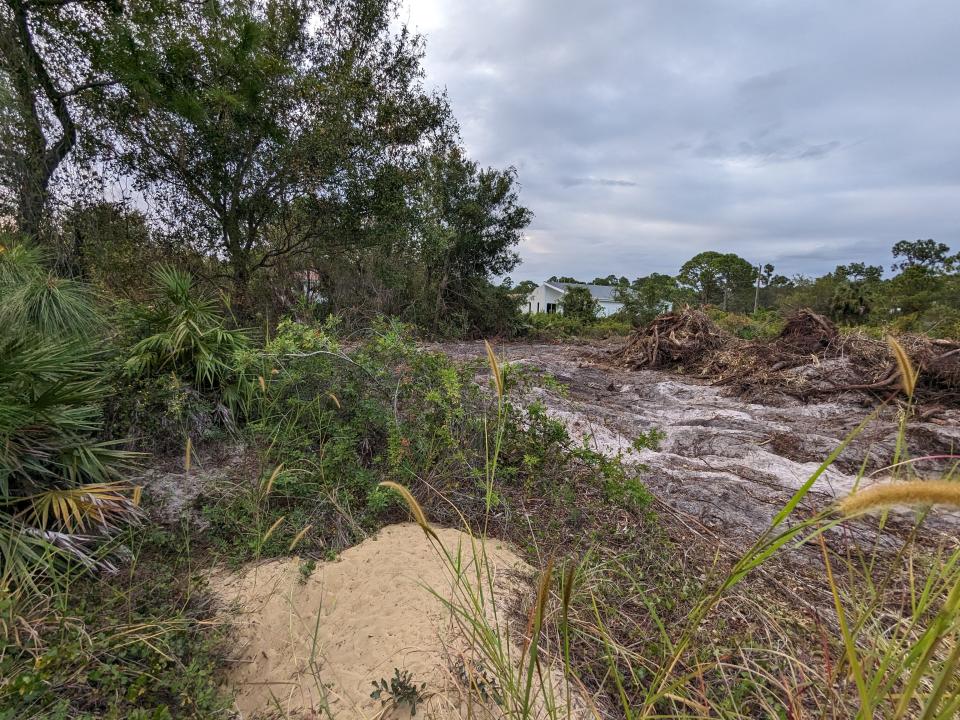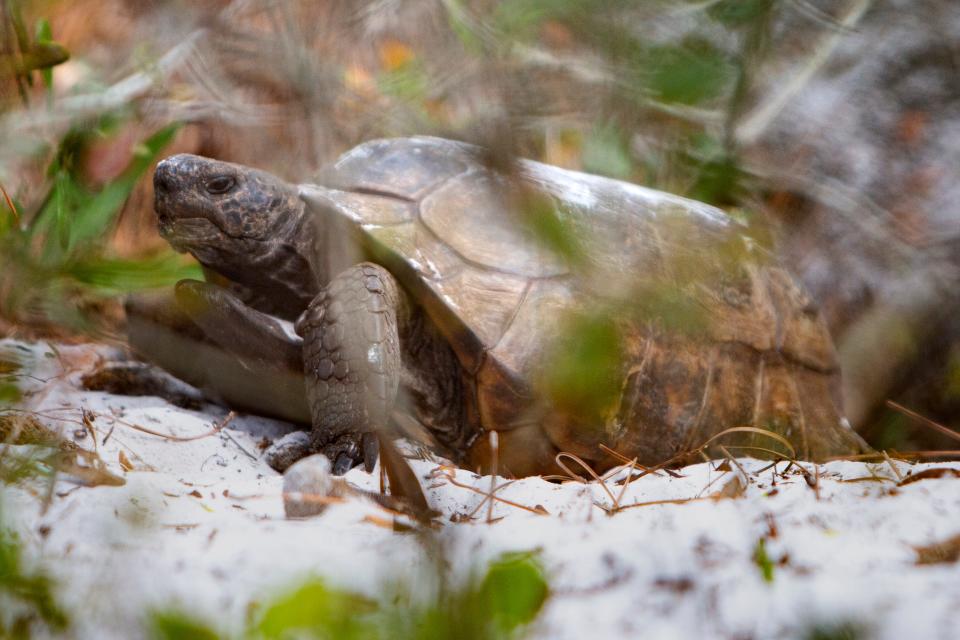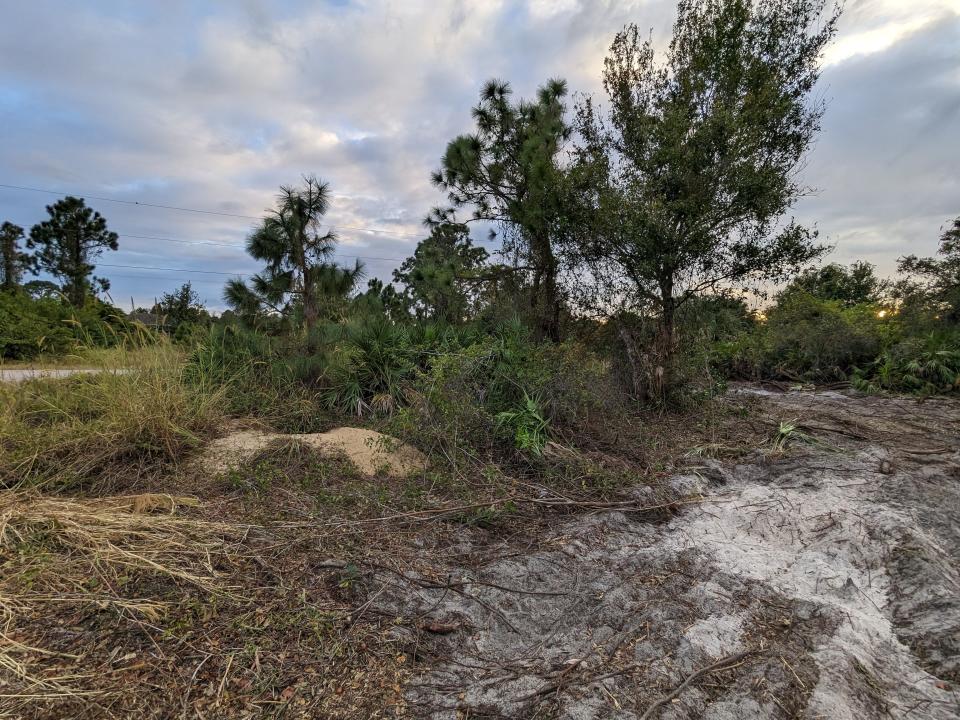Buried alive? Gopher tortoise burrows collapsed in Lehigh Acres; major work halted 30 days

Collapsed burrows. Alarmed neighbors. Slow agency response.
The destruction of a once-thriving gopher tortoise community in Lehigh Acres last week typifies what’s happening to the threatened species throughout Southwest Florida, advocates say.
The state wildlife agency finally put a halt to heavy equipment work on two adjoining Carbon and Carpenter Street properties Thursday, but not until a tractor had rolled over several tortoises’ homes, likely trapping their occupants underground.

It didn’t have to go this way, says neighbor Kara Tyler-Julian, who began warning the Florida Fish and Wildlife Conservation Commission about the animals’ presence last April. She wanted to be sure that when the land was developed, the reptiles would be protected — something to which they’re legally entitled as a state-declared threatened animal. The agency is looking into what went wrong, a spokesman said.

Gopher tortoises are a keystone species: one that others in natural systems depend on. Their burrows can host more than 300 other creatures, many of them also protected, like eastern indigo snakes, burrowing owls and rabbits.
The tortoises tend to favor the high-and-dry uplands that humans do, which can lead to conflict when humans want to develop that land and then find resident tortoises.
'Clearing away nature a quarter-acre acre at a time'
Though large-scale projects must include surveys for threatened animals in unincorporated Lee County, for smaller home sites, there are no such advance requirements.
That's had devastating consequences for the tortoises, says Associate Professor Nora Demers, biologist in FGCU’s department of biological sciences. If a project is greater than 10 acres or proposes more than two acres of impervious cover, says Lee County spokeswoman Betsy Clayton, advance mapping and surveying are required. "Lee County does not require wildlife surveys prior to clearing on 1-acre or less lots for a single-family home," she wrote in an email, in which she also pointed out "FWC, not Lee County, is the regulatory authority for gopher tortoises."
If residents see a suspected wildlife violation, Clayton wrote, they should call the FWC Wildlife Alert Hotline at 888-404-3922. Yet that's just what Tyler-Julian did, with results that left her beyond frustrated. She's not alone, she says: "Many other citizens of Lehigh have the same story as me with the same result," she wrote to Senior FWC Officer Adam Brown: "FWC not helping and not doing anything about it."
Brown told The News-Press he's looking into the communication timeline and what happened.
FWC inaction is a recurring theme on social media, including the Lehigh Acres Florida Gopher Tortoise Preservation Facebook group, which James Kennedy of Alva helps administer. "Incidents like this highlight the threat of overdevelopment and poor resource management to the state’s biodiversity," he said, and point up the need for stronger agency action. Kennedy's not blaming the agency, he says. "They do not have the people or resources for the size of the job we ask of them," though he notes "Quicker response might have prevented the destruction of the burrows. With the 30 day hold, the tortoises may be able to dig out if they aren’t suffocated or crushed. But the damage to the burrows and possible deaths of the tortoises doesn’t just affect the tortoises," Kennedy said; it jeopardizes all the other species that depend on them.
"Without better enforcement and protection the damage to Florida will be irreparable. The state leaves it to local jurisdictions to enact more restrictive permitting requirements and some counties pretty much ignore their responsibility for protecting the environmental resources in their area," Kennedy said. "It’s really important that local governments enact and enforce better protections or the species is going to be lost. And really, what reasonable person is okay with possibly burying an animal alive if they can help it?"

What makes this environmentally devastating, Demers says, is all the chronic small violations add up to massive impacts. “If you have a thousand quarter-acre lots being bulldozed, that’s as bad as a thousand-acre development … we’re just clearing away nature a quarter-acre acre at a time.”
Several tortoise burrows completely collapsed
Once she saw the impending development writing on the wall, Tyler-Julian documented the well-used burrows, complete with fresh tracks and fresh droppings, to capture the “before” landscape so it could be compared with the “after.”
Tortoises in trouble: With gopher tortoise projections 'really harrowing', nonprofits sue over protections
The agency had told her she'd have to wait until clearing started because it couldn't act until then. So earlier this month, when heavy equipment rolled onto the property to clear it, she dialed the hotline.
“We saw a tractor pushing trees over on the lot, so we called.” Tyler-Julian spoke to a dispatcher, but no one reached back.
She called again. And again.
Finally, she flagged down the tractor operator to stop him before he caved in the two biggest burrows, though he came within a few feet. “But at least four burrows that I know of were completely collapsed,” she said.
It wasn’t until Monday that the agency got back to her. By then, several of the burrows had been obliterated by the heavy equipment. Though there’s no way to know for sure if they were occupied at the time, odds are good, she says. “The lot was being cleared during the hours when they’re typically inside their burrows.”
Reached by phone, FWC Officer Adam Brown said tortoises can sometimes dig out after their burrows are buried, which the 30-day heavy equipment pause may give them a chance to do.
Brown also said the agency could have done a better job responding. On weekends, many officers of the agency are law-enforcing on the water, and on the weekend when the clearing happened, they were stretched even thinner than usual with the opening of hunting season at the Babcock/Webb Wildlife Management Area.
In an email, Brown said an FWC officer visited the location Nov. 6, and found "a vacant partially cleared lot with two potentially impacted burrows within 25 feet of the clearing. The officer contacted the construction company and advised them that an FWC Disturbed Site permit would be required before resuming any further clearing. An FWC biologist has attempted to contact the property owner regarding the proper steps to move forward. The investigation is currently ongoing."
The permit forbids heavy equipment work for 30 days, though hand-tools are allowed, Brown said. The agency takes tortoise protection seriously, he says. Florida statutes say anyone who intentionally takes, harasses, wounds, or kills any species designated as endangered, threatened, or of special concern and "any person who violates this provision regarding an endangered, threatened, or of special concern species" is guilty of a felony in the third degree, which is punishable by up to five years in prison and/or a fine of up to $5,000."
The land belongs to a Weston LLC, Innova Investments Group, which owns the two adjoining Lehigh Acres parcels. Using publicly available phone records, The News-Press placed a call to Freddy Pereira, listed on state filings as the group’s registered agent, but though the man who answered the phone initially said he was Pereira, he said in Spanish there'd been a mistake and disavowed in Spanish any knowledge of the project.
Tyler-Julian know residents walk a fine line with their neighbors when reporting tortoises.
“You don't want to be accused of being a Karen, but if FWC isn’t doing their job, what are you going to do? Why is it on the citizens to enforce the law?”
The episode has left Tyler-Julian deeply disappointed.
"I followed all of the right channels, I reached out to FWC multiple times and the only thing that stopped the tractor was me running in front of the last two burrows when I couldn't stand it anymore. My evidence and calling and pleading with (the agency) beforehand wasn't enough, so what is enough? What will it take for FWC to A) Stop this from happening and B) Prosecuting when it does happen?" she asked. "Because from my experience it seems there is nothing that citizens can do with FWC to stop this or help get these folks prosecuted."
This article originally appeared on Fort Myers News-Press: Gopher tortoise burrows in SW Florida destroyed despite advance notice

